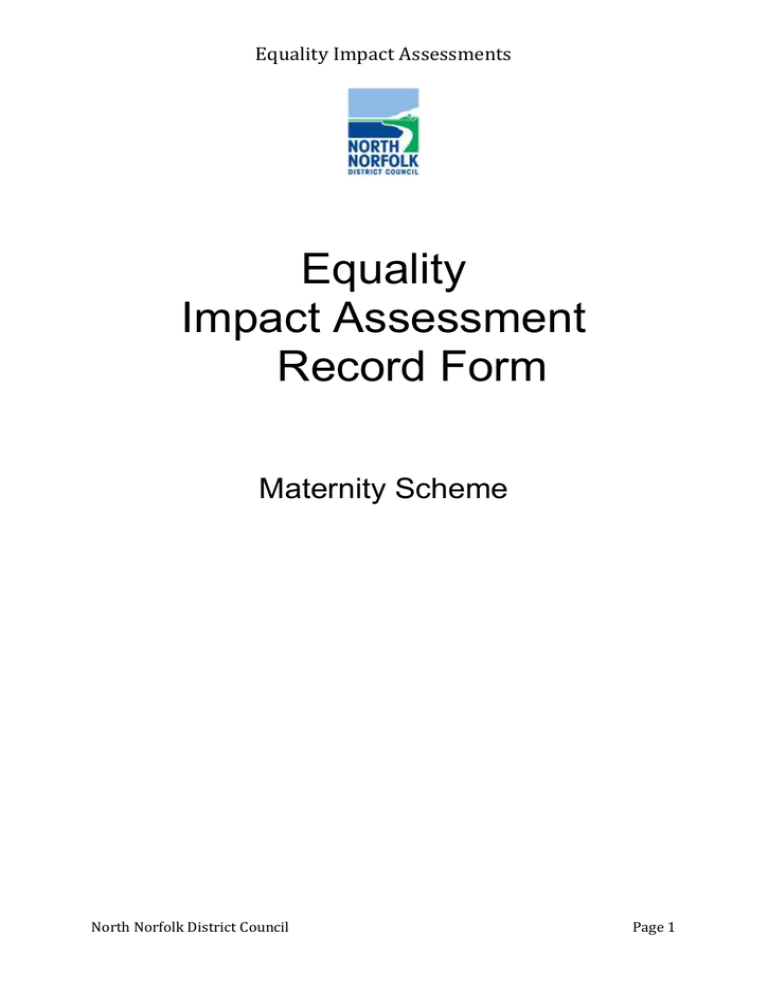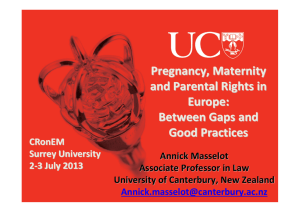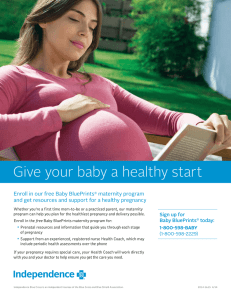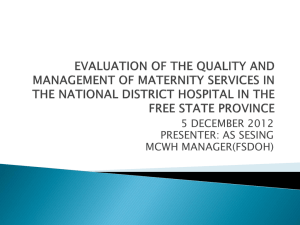Equality Impact Assessment Record Form
advertisement

Equality Impact Assessments Equality Impact Assessment Record Form Maternity Scheme North Norfolk District Council Page 1 2 Equality Impact Assessments Directorate Resources Title of the assessed policy being Service Person Date responsible for assessment the assessment completed Human Resources/Organisational Development Maternity Scheme (2003) HR Officer 28/09/2009 The status of the policy Existing – due to be reviewed. *Please note this scheme is on the policy review programme 1. What are the aims, objectives and purposes of the policy? 3. Who is intended to benefit from the policy, To comply with relevant legislation including the Management of Health & Safety at Work Regulations 1999; Maternity & Parental Leave Regulations 1999; Pregnant Workers Directive; and Employment Rights Act 1996. To support employees through the maternity period, to be a good employer and to support and retain our employees by helping achieve work life balance during their maternity period and on their return to work. This scheme also sets out to employees their entitlements and responsibilities under the scheme. Yes: Health and Safety – specific regulations – and through undertaking risk assessments Pension Scheme – links drawn regarding contributions to the scheme Job Share Policy – Employees may wish to alter their working hours on return from maternity leave and this is one way of achieving this Duty to consider requests to work flexibly – these requests are often made at the point of return from maternity leave (under the Employment Rights Act 1996, as amended) Legal compliance – with legislation as listed above in section 1. Green book – part 2, section 11 on ‘The Maternity Scheme’ it also links to the Council’s Maternity Support Leave Scheme, which has been equality impact assessed separately. Attendance Policy – regarding pregnancy related sickness (this policy has been equality impact assessed separately). Corporate Plan – values of ‘Valuing Staff’ and ‘Equality & Diversity’ All pregnant employees, as well as those thinking about pregnancy, employees who are on maternity leave, and employees due to return from maternity leave. North Norfolk District Council Page 3 2. Does the policy support other objectives of the council? and in what way? 4. What outcomes are anticipated from the policy being in place? 5. Identify and select your assessment team. It also provides information and acts as a source of reference for all parties involved – employees, managers, UNISON and Human Resources. ICAS (Employee Assistance Programme) – Provides the telephone advisers with contextual information on which they can base their advice, when contacted by a member of staff Clear information for all parties concerned, although this will need to be updated to provide the correct information. Support for staff pre, post and during pregnancy. Good retention rates following the end of maternity leave (currently we have 87% returning at the end of their maternity leave). Assist employees to achieve a good work life balance. Name Role HR Officer Consultees – See Appendix A 6. What data have you gathered for this assessment? How have you analysed this data? HR Officer Various Source and Age of Data Maternity figures from the 1st April 2005. Data correct to 2009 and from cognos. (Cognos is a tool that allows us to create reports from the information held on the Human Resources computer system – ‘Resource link’) Responsibilities Owner Human Resources 4 Lead on assessment Consultees Findings Data Gaps The age, disability status and ethnicity of employees who have taken maternity leave. It also details what has happened following the end of maternity leave i.e. returners/nonreturners and any adjustments to hours. Key statistics can be found in Appendix C. It was possible to analyse the data by ethnicity, age and disability status. It was not possible to analyse by sexual orientation or religion/belief as we do not currently hold that data on our employees. Data is only available in this format since 2005; however there are three full years of data to work on. For some of the employees it is not yet known whether or not they will return, or on what hours (hence why there are three full years of data rather than four). INTRAN pages of Customer Services Services that INTRAN n/a intranet can offer North Norfolk District North Norfolk District Guidelines on how to n/a Councils accessibility Council make information more matters standards accessible Views from employee Human Resources Changes made following n/a representatives this consultation are regarding the listed in Appendix A. assessment Average (mean) age to ONS – Office for For 2008 the average n/a become a mother (2008) National Statistics age to become a mother was 29.5 years of age 7. Who are the main stakeholders of this policy? 8. Are there any concerns that the policy could have a negative impact with regard to race and ethnicity? Community Staff/Members Employees Managers Members Trade union representatives Human Resources/payroll Health and Safety team Partners ICAS (employee assistance programme provider) What evidence (actual data or assumptions) do you have to support this? No This scheme provides information for employees regardless of race/ethnicity, pre, post and during pregnancy. In addition to this the Council has and operates an Equal Opportunities Policy to ensure all staff are treated fairly, regardless of their background. However, there is no ‘equalities statement’ in this scheme to reinforce the policy. The scheme would have been consulted upon with UNISON prior to implementation 5 in 2003. Also it is derived from the provisions of the ‘Green Book’ which are the terms and conditions for Council employees, which are negotiated at a national level. ‘INTRAN’ services (translation) would also be available if there was a need to communicate the scheme in another language, for example. In terms of the uptake of the Council’s maternity scheme, 25 people have started their maternity leave since 1 April 2005. All of these have been ‘White British’. This is not considered surprising when the majority (95.4%) of employees at NNDC are White British. Whilst none of the employees who are not listed as ‘White British’ have taken maternity leave, it is recognised that that ethnic make up of the workforce is predominantly ‘White British’. Therefore the conclusion is that there is currently no evidence of an adverse impact on a particular ethnic group in the analysis of either the scheme itself or the available data. 9. Are there any concerns that the policy could have a negative impact with regard to gender? What evidence (actual data or assumptions) do you have to support this? This scheme provides information for employees, pre, post and during pregnancy. By virtue of the nature of pregnancy however, this policy can only apply to those who are biologically able to have children i.e. women. Yes – This policy only applies to women. The scheme would have been consulted upon with UNISON prior to implementation in 2003. Also it is derived from the provisions of the ‘Green Book’ which are the terms and conditions for Council employees, which are negotiated at a national level. As women are more likely to be working part time (40.7% of women, compared to 16.5% of men at North Norfolk District Council), to ensure that all these employees receive the information on any changes to the scheme in the future, any briefing sessions would need to be timed appropriately to catch as many employees, on as many different working patterns as possible – e.g. different days of the week, times etc. The scheme should also be communicated in a number of different formats – intranet, briefing newsletter, team briefings etc. All communications should comply 6 with the Council Accessibility Matters Standards. The scheme is specifically designed for women and thus is not open to men. However this is felt to be justified as it is not possible for a biological male to become pregnant and there are other schemes available for those with caring responsibilities, which includes men. The most obviously example is the Maternity Support Leave Scheme and the Statutory Paternity Scheme. 10.Are there any concerns that the policy could have a negative impact with regard to disability? What evidence (actual data or assumptions) do you have to support this? This scheme provides information for employees regardless of disability status, pre, post and during pregnancy. In addition to this the Council has and operates an Equal Opportunities Policy to ensure all staff are treated fairly, regardless of their background. However, there is no ‘equalities statement’ in this scheme to reinforce the policy. The scheme would have been consulted upon with UNISON prior to implementation in 2003. Also it is derived from the provisions of the ‘Green Book’ which are the terms and conditions for Council employees, which are negotiated at a national level. No This scheme should be communicated in a number of different forms – e.g. intranet, team briefing & briefing newsletter. Communications would need to comply with the Council’s Accessibility Standards. ‘INTRAN’ services (translation) would also be available if there was a need to communicate the procedure in sign language or Braille for example. It is possible that some health conditions/and or disabilities may lead to different or extra antenatal care e.g. additional screening or more regular check ups. This could be true for diabetic employees, some of which may be considered disabled under the Disability Discrimination Act. There is no specific mention of this in the scheme but all employees are entitled to ‘reasonable paid time off’ for antenatal care. What is reasonable will depend on the circumstances, and the Council would consider reasonable adjustments in the case of disability. 7 None of the employees who have commenced their maternity leave since 1 April 2005 have been disabled. This is not felt to be significant as only 1.73% of the female workforce population are disabled, and the average age of this group is 50 years of age, which is higher than both the average age for having a child at NNDC, and nationally (see below). 11.Are there any concerns that the policy could have a negative impact with regard to age? What evidence (actual data or assumptions) do you have to support this? This scheme provides information for employees regardless of age, pre, post and during pregnancy. There are however biological limitations for child bearing ages, and the current average age for a woman to have a child is 29.5 years (ONS, 2008). For information current data (from tax year 2008) for North Norfolk District Council shows that the age varies from those in their 20’s to those in their 40’s. The average age for those taking maternity leave in tax year 2008 however was 35 years of age. No The Council has and operates an Equal Opportunities Policy to ensure all staff are treated fairly, regardless of their background. However, there is no ‘equalities statement’ in this scheme to reinforce the policy. The scheme would have been consulted upon with UNISON prior to implementation in 2003. Also it is derived from the provisions of the ‘Green Book’ which are the terms and conditions for Council employees, which are negotiated at a national level. It is not felt that the scheme itself or the data regarding the scheme is biased towards any particular age group. There are natural limitations on childbearing ages, which vary between individuals and are interdependent with other factors. Any employee who was pregnant, regardless of age, would be entitled to maternity leave. 12.Are there any concerns that the policy could have a negative impact with regard to religion/belief? What evidence (actual data or assumptions) do you have to support this? No This scheme provides information for employees, regardless of religion/belief, pre, post and during pregnancy. In addition to this the Council has and operates an Equal Opportunities Policy to ensure all staff are treated fairly, regardless of their background. However, there is no ‘equalities statement’ in this scheme to reinforce the policy. 8 The scheme would have been consulted upon with UNISON prior to implementation in 2003. Also it is derived from the provisions of the ‘Green Book’ which are the terms and conditions for Council employees, which are negotiated at a national level. It is not possible to analyse the take up or details surrounding maternity by religion/belief as the Council does not currently collect this data for employees. Therefore it is not possible to draw conclusions regarding religion/belief at this time on the basis of statistics, but it is not felt that there is anything in the scheme itself which lends to discrimination on the basis of religion/belief. 13.Are there any concerns that the policy could have a negative impact with regard to sexual orientation? What evidence (actual data or assumptions) do you have to support this? This scheme provides information for employees, regardless of sexual orientation, pre, post and during pregnancy. Women in same sex relationships who are pregnant are entitled to exactly the same provisions as those in heterosexual relationships. In addition to this the Council has and operates an Equal Opportunities Policy to ensure all staff are treated fairly, regardless of their background. However, there is no ‘equalities statement’ in this scheme to reinforce the policy. No The scheme would have been consulted upon with UNISON prior to implementation in 2003. Also it is derived from the provisions of the ‘Green Book’ which are the terms and conditions for Council employees, which are negotiated at a national level. It is not possible to analyse the take up or details surrounding maternity by sexual orientation as the Council does not currently collect this data for employees. Therefore it is not possible to draw conclusions regarding sexual orientation at this time on the basis of statistics, but it is not felt that there is anything in the scheme itself which lends to discrimination on the basis of sexual orientation. 9 14.Could the negative impact you have identified in questions 8 - 13 lead to the potential for adverse impact if the policy is implemented? Yes This scheme is for the child-bearer only and therefore cannot be made open to males. It is not possible to mitigate this, due to the biological nature of pregnancy. However, there are provisions available to men or other partners/nominated carers which could be highlighted in this scheme. Can this adverse impact be justified on the grounds of promoting equality of opportunity for one group? N/A For justification, see above. Or any other reason? Yes See box 14 Can the impact be mitigated by existing means? No See box 14, but make links to the options that are available to all those involved – fathers/partners/nominated carers. If yes, what actions will you undertake to mitigate these impacts and revise the policy? 15.Describe the arrangements for reporting and publishing this assessment. As above. This assessment will be reported to the Equality and Diversity Board and will be published on the NNDC external website (www.northnorfolk.org) Has this assessment been undertaken by a minimum of two staff? Has this assessment been scrutinised by your Directorate Steering Group? Yes If the policy is new, or requires a decision by Councillors to revise, has this Equality Impact Assessment been included with the report? 10 This has been scrutinised by Organisational Development Equality Impact Assessment team Yes Have any actions identified in this assessment been included in your service equality and diversity action plan? Completed by: HR Officer Signed off by: 11 See Appendix B Organisational Development Manager Appendix A – Consultation information and Edits People consulted in the assessment: HR Assistant HR Advisor Unison representative Supporting Communities Manager Actions taken after consultation: Additional stakeholder added to section 7 Addition of ICAS to sections 3 & 7 12 Appendix B – Action Plan Action Review the scheme ASAP to bring the information up to date with current legislation and best practice. Cross reference with the Attendance Policy regarding sickness – pregnancy/ non-pregnancy related and include a section in the Attendance Policy also. Expected Outcome Person responsible Whilst the Council does in practice HR Officer comply with all legislation in the area, this is not recorded. A revised scheme would make this clearer and provide evidence of compliance. It would also ensure that employees are getting the correct information and are aware of the options available to them. To ensure congruence between HR Officer policies/procedures /schemes Review the Equality Impact Assessment Continuing commitment to equality, HR Officer on an annual basis and a full review where changes have been made, or new every three years; or at the point which evidence is available the policy is reviewed – whichever is sooner Include Sexual Orientation and To ensure there is no cause for concern HR Officer Religion/Belief in monitoring of with regard either of these groups in the employees in general and therefore in the application of the Scheme. continuing monitoring of the use of the 13 Target date ASAP in 2010 During review of Attendance Policy (late 2009) and review of Maternity Scheme ASAP in 2010. When Maternity Scheme is reviewed or after 12 months – whichever is sooner Ready to report on March 2010. Maternity Scheme. This would require an update from current employees and the data to be collected for all new employees. This would also eliminate areas where equality data is ‘not known’. Include an Equalities statement in the To link the scheme to the wider HR Officer Maternity Scheme equalities agenda of North Norfolk District Council and reinforce the Equal Opportunities Policy to ensure all staff treated fairly and consistently regardless of background. Consider combining maternity scheme in To increase awareness and ease of HR Officer with other family friendly access for employees with caring policies/procedures to increase commitments to increase work life awareness and ease of access for all balance. This would also draw links employees by providing a ‘one stop shop’ between policies and highlight additional options e.g. parental leave, emergency time off for dependents 14 When Maternity Scheme is reviewed ASAP in 2010 ASAP as part of policy review 2010 Appendix C – Key Statistics on Maternity 23 people have commenced and finished their maternity leave since 1 April 2005. A further six have commenced their leave, but have not yet finished it. Of the 23 whose leave has finished, 20 returned at the end of the maternity leave period (87%). Of these 20, 19 are still employed (95%); this gives an overall retention rate of 82.6% for those going on maternity leave. 100% of the employees were White British 100% of the employees had not declared themselves as disabled Flexibility in working hours is extended to those returning to work where possible. Some chose to change their working pattern as soon as they return, whilst others may decide to look at this at a later date. Of the 20 returners, 13 have opted to change their working hours – this equates to 65%. Some employees (four or 20%) have changed their hours more than once. Source: Maternity Figures Spreadsheet & Data from HR information System – Resource Link. 15 Equality Impact Assessments North Norfolk District Council Page 16



